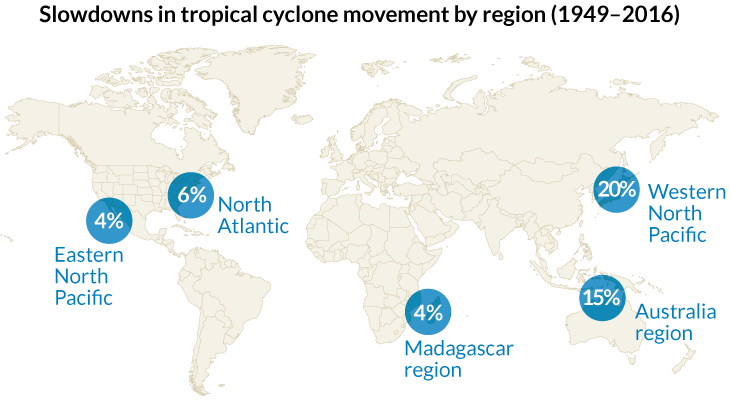
TROPICAL TORRENTS Tropical cyclones, such as 2017’s Hurricane Harvey (shown making landfall), are moving more slowly, potentially making them more dangerous.
NOAA
- More than 2 years ago
Tropical cyclones don’t move as fast as they used to.
The fierce, swirling storms move 10 percent slower, on average, than they did nearly 70 years ago, a new study finds. Such lingering storms can potentially cause more damage by dumping even more rainfall on land beneath them.
Atmospheric scientist James Kossin examined changes in how quickly tropical cyclones, known as hurricanes in the Atlantic Ocean, moved across the planet from 1949 to 2016. Storms slowed at different rates depending on the region, with the biggest changes seen in the Northern Hemisphere, Kossin reports in the June 7 Nature.
Over that same time period, the average temperature of Earth’s surface rose by about half a degree Celsius. Scientists already predict that average wind speeds will increase in tropical cyclones as ocean waters warm due to global warming (SN: 6/27/15, p. 9). The new study suggests that climate change is also altering how quickly these tropical cyclones travel across land or water.
The effect was even more pronounced as storms moved over land, with those originating in the western North Pacific, such as near Japan, slowing by 30 percent. Storms coming in from the North Atlantic – such as 2017’s Hurricane Harvey — are moving 20 percent slower over land, says Kossin, of the National Oceanic and Atmospheric Administration’s National Centers for Environmental Information in Madison, Wis.
Stalling storms
The largest decreases in tropical cyclone travel time are in the western North Pacific Ocean region (20 percent). Once on land, those storms travel 30 percent more slowly than they did 70 years ago (not shown).

The new study makes an important link between the atmospheric effects of global warming to its effects on tropical cyclones, says atmospheric scientist Christina Patricola of the Lawrence Berkeley National Laboratory in California, who also wrote a commentary that accompanies the new paper. “Tropical cyclones tend to move along with larger-scale [atmospheric] circulation around them,” she says. “Kossin perceptively hypothesized that this overall slowdown would also affect tropical cyclones.”
It’s not clear whether the slowdown will continue into the future, or how it might vary regionally, Patricola says. Most previous work has focused on how climate change will affect the wind speeds of storms rather than how quickly they travel, known as the translation speed. “But in order to have the best information for building resilience to storms, we need to understand these other characteristics,” she says.
The cyclone slowdown is consistent with a weakening in atmospheric circulation in the tropical parts of the planet, a result of global warming, Kossin found. Global warming is also expected to increase how much water vapor the atmosphere can hold, which means storms could accumulate more moisture before releasing it in rainfall.
Slow-moving Hurricane Harvey, which dumped record levels of rain while lingering for days over southern Texas, could be a harbinger of things to come.







